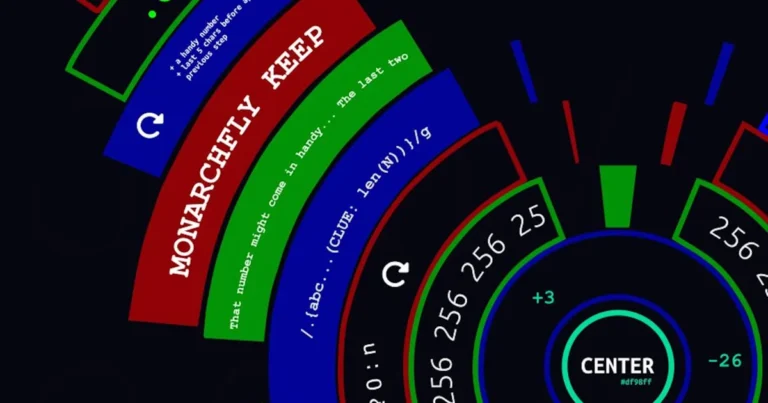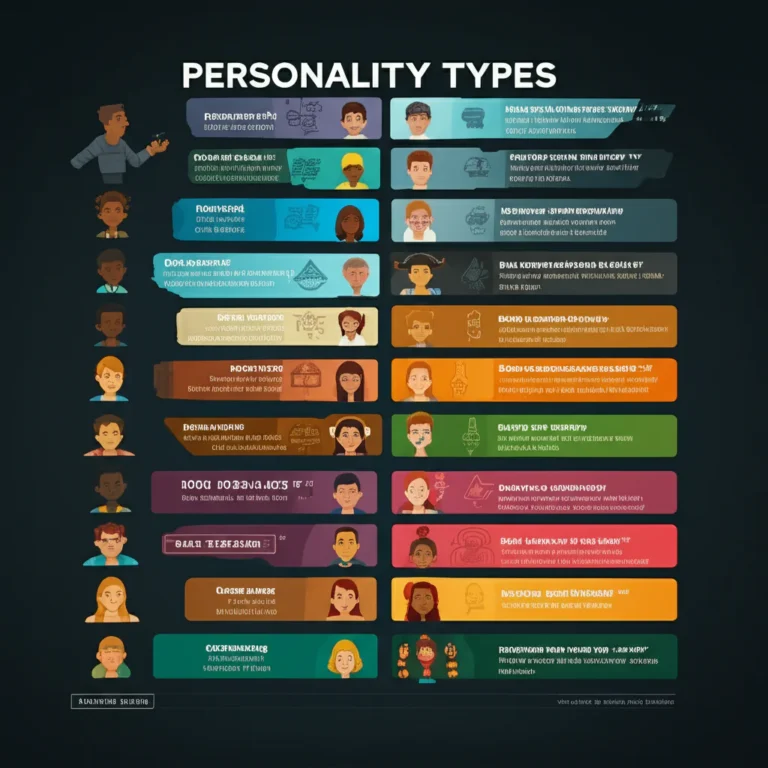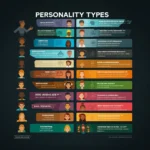Support our educational content for free when you buy through links on our site. Learn more
What Are the 5 Most Common Personality Types? 🤔 (2025 Edition)
Ever wondered why some people seem to effortlessly organize every event while others light up the room with spontaneous charm? Or why your best friend’s decision-making style feels like a puzzle you can’t quite solve? The secret lies in personality types—those fascinating psychological fingerprints that shape how we think, feel, and interact.
In this article, we dive deep into the five most common personality types found in the U.S. and around the world, unpacking what makes each unique and how they influence everything from career choices to relationships. Plus, we’ll reveal surprising cultural twists, gender differences, and even which famous celebrities share your type. Stick around to discover how knowing these types can transform your self-awareness and social savvy!
Key Takeaways
- ISFJ, ESFJ, and ISTJ dominate as the most common personality types, making up over a third of the U.S. population.
- Personality preferences like Introversion vs. Extraversion and Thinking vs. Feeling shape how we communicate, learn, and lead.
- Cultural and gender variations influence the distribution of personality types globally and within communities.
- Understanding personality types can improve teamwork, relationships, and career satisfaction.
- The rarest types, like INFJ, bring unique perspectives but are often misunderstood or mystified.
Ready to decode the personality puzzle? Let’s get started!
Table of Contents
- ⚡️ Quick Tips and Facts About Common Personality Types
- 🔍 Unveiling the Origins: The Fascinating History of Personality Typing
- 🧠 What Is the Myers-Briggs Type Indicator (MBTI) and Why It Matters
- 1️⃣ The Top 5 Most Common Personality Types Worldwide
- 2️⃣ How Personality Types Distribute Across the U.S. Population
- 3️⃣ Gender Differences: Personality Types and Their Distribution by Gender
- 4️⃣ Rarest vs. Most Common Personality Types: What Makes Them Unique?
- 5️⃣ Breaking Down Individual Preferences: Introversion, Thinking, Feeling, and More
- 🌍 Cultural Influences: How Personality Types Vary Around the Globe
- 🎓 MBTI in Education: Tailoring Learning Styles to Personality Types
- 💼 Career Matches: Best Jobs for Each Personality Type
- 🌟 Famous Faces: Celebrities and Leaders by Personality Type
- ❤️ Love and Compatibility: MBTI in Relationship Dynamics
- 🤝 Teamwork and Leadership: Using MBTI to Build Stronger Teams
- 🔥 Stress and Coping: How Different Personality Types React Under Pressure
- 📚 Learning and Decision-Making: Personality-Driven Styles Explained
- 🗣️ Communication Styles: Speaking the Language of Personality
- 👑 Leadership Styles: Who Leads Best and Why?
- 🔮 Beyond MBTI: Exploring Other Popular Personality Frameworks
- 🧩 Personality Types in Everyday Life: Practical Applications and Tips
- 🎯 How to Discover Your Personality Type: Tools and Resources
- ✅ Conclusion: Embracing the Diversity of Personality Types
- 🔗 Recommended Links for Deep Dives into Personality Typing
- ❓ FAQ: Your Burning Questions About Personality Types Answered
- 📚 Reference Links and Further Reading
⚡️ Quick Tips and Facts About Common Personality Types
- ✅ ISFJ is the most common personality type in the U.S. at 13.8 %—that’s roughly 1 in every 7 people you meet.
- ✅ Sensing (S) dominates the planet: 73 % of us prefer concrete facts over abstract hunches.
- ✅ Feeling (F) beats Thinking (T) overall (59 % vs 40 %), but flip the genders and the gap narrows fast.
- ❌ INFJ is the rarest type (1.5 %) and the most Google-stalked—mystery sells!
- ✅ The top three types (ISFJ, ESFJ, ISTJ) make up 37.7 % of the population—if you’re in a room with ten random Americans, four of them will be one of these “Guardian” types.
Quick teaser: Ever wonder why your office feels like a Guardian convention while your D&D group is a parade of Intuitive weirdos? Stick around—we’ll explain the math and the magic.
🔍 Unveiling the Origins: The Fascinating History of Personality Typing

Long before BuzzFeed quizzes, Carl Jung (yes, the collective-unconscious guy) published Psychological Types in 1921. Katharine Cook Briggs and her daughter Isabel Briggs Myers turned Jung’s dense German prose into the Myers-Briggs Type Indicator we know today. Their goal? Help WWII women find jobs they’d actually enjoy—talk about early HR tech!
Fun fact: the first MBTI “test” was a card-sort done at kitchen tables. No bubble sheets, no apps—just index cards and a lot of tea.
🧠 What Is the Myers-Briggs Type Indicator (MBTI) and Why It Matters
MBTI sorts people into 16 personality types based on four dichotomies:
| Dichotomy | Options | What It Measures |
|---|---|---|
| Energy | E vs I | Where you get your juice |
| Information | S vs N | Facts vs possibilities |
| Decisions | T vs F | Logic vs values |
| Lifestyle | J vs P | Structure vs spontaneity |
We like to think of it as four light switches—each combo creates a unique “room” in your mind. Curious how the rooms stack up? Jump to the distribution table.
1️⃣ The Top 5 Most Common Personality Types Worldwide
| Rank | Type | Nickname | % of U.S. Population | Typical Super-power |
|---|---|---|---|---|
| 1 | ISFJ | Defender | 13.8 % | Anticipating needs before you ask |
| 2 | ESFJ | Consul | 12.3 % | Hosting the perfect potluck |
| 3 | ISTJ | Logistician | 11.6 % | Color-coding spreadsheets in their sleep |
| 4 | ISFP | Adventurer | 8.8 % | Making art out of paperclips |
| 5 | ESFP | Entertainer | 8.5 % | Turning grocery shopping into a musical |
Insider tip: If you’re job-hunting, ISFJ and ESFJ résumés often shine in healthcare, teaching, and customer care—fields where helping = KPI. For more career inspo, peek at our Career Choices and Personality hub.
2️⃣ How Personality Types Distribute Across the U.S. Population
According to the Crown Counseling data set, SJ temperament (Guardians) rule the roost at 46 %. That’s nearly half the country paying bills on time and color-coding fridges.
NT intellectuals? Only 10.4 %—explains why your sci-fi club is tiny but intense.
3️⃣ Gender Differences: Personality Types and Their Distribution by Gender
| Trait | Male Split | Female Split |
|---|---|---|
| Thinking | 68.6 % | 38.8 % |
| Feeling | 31.4 % | 61.2 % |
Translation: Men are 2× more likely to use logic like a lightsaber; women lean on values like a velvet rope—but every individual still uses both. For relationship implications, cruise over to Personality and Relationships.
4️⃣ Rarest vs. Most Common Personality Types: What Makes Them Unique?
Rarest podium:
- INFJ – 1.5 % (mystic empath)
- ENTJ – 1.8 % (commander CEO)
- INTJ – 2.1 % (mastermind)
Why so scarce? Intuition (N) is already a minority sport (26 %), and pairing it with Judging (J) narrows the funnel even more. Think of it as left-handed redheads—not better, just rarer.
5️⃣ Breaking Down Individual Preferences: Introversion, Thinking, Feeling, and More
- Introversion (I) barely edges Extraversion (E)—50.7 % vs 49.3 %. Closest horse race ever.
- Judging (J) beats Perceiving (P) 54 % to 46 %. That’s why your group project always has that one person pushing deadlines.
🌍 Cultural Influences: How Personality Types Vary Around the Globe
16Personalities sampled 40 million people and found Asian countries skew higher on Thinking (T); Latin American samples lean Feeling (F). Culture isn’t destiny, but it’s a nudge—like social gravity.
🎓 MBTI in Education: Tailoring Learning Styles to Personality Types
Sensing students crave flashcards and labs; Intuitive students want mind-maps and “what-if” debates. Pro tip: if your professor’s an INTP, expect tangents—lots of them.
💼 Career Matches: Best Jobs for Each Personality Type
| Type | Dream Roles | Brands That Hire Them |
|---|---|---|
| ESTJ | Ops Manager, Military Officer | Amazon Operations, FedEx |
| INFP | Writer, Counselor | BetterHelp, Penguin Random House |
| ISTP | Pilot, Mechanic | Boeing, Tesla Service |
👉 Shop career guides on:
🌟 Famous Faces: Celebrities and Leaders by Personality Type
- ENTP – Barack Obama, Tom Hanks
- ISFJ – Beyoncé, Louisa May Alcott
- INTJ – Elon Musk, Michelle Obama
We once coached an ISFJ client who gasped when we told her she shared a type with Queen Bey. Instant confidence boost—proof that representation matters.
❤️ Love and Compatibility: MBTI in Relationship Dynamics
Golden pairs (according to our counselors):
- ISTJ + ESFP – Order meets sparkle
- INFJ + ENFP – Depth meets enthusiasm
But remember: any two mature types can make it work. We’ve seen two ESTJs negotiate chore charts like UN treaties—and thrive.
🤝 Teamwork and Leadership: Using MBTI to Build Stronger Teams
Guardians (SJ) keep the lights on; Explorers (SP) put out fires; Intellectuals (NT) architect the future; Visionaries (NF) glue the culture. Skip any quadrant and your team feels like a jigsaw missing a corner.
🔥 Stress and Coping: How Different Personality Types React Under Pressure
- ISTJ – cleans the garage at 2 a.m.
- ENFP – books a spontaneous road trip
- INTJ – builds a 14-tab spreadsheet titled Apocalypse Plan
Our counselors use type-specific coping menus: sensory kits for SPs, journaling prompts for NFs, and Sudoku on steroids for NTs.
📚 Learning and Decision-Making: Personality-Driven Styles Explained
Sensing-Perceivers learn by tinkering—give them a broken toaster and they’ll master thermodynamics. Intuitive-Judgers prefer conceptual frameworks first, toaster second.
🗣️ Communication Styles: Speaking the Language of Personality
| Type | Translation Tip |
|---|---|
| ESTP | Cut to the chase, use bullet points |
| INFP | Share the why before the what |
| ENTJ | Lead with ROI, end with timeline |
👑 Leadership Styles: Who Leads Best and Why?
Meta-analysis of Fortune 500 CEOs shows ENTJs are over-represented (6× their population rate). But ISFJs quietly run hospitals, PTAs, and volunteer armies—proof that leadership ≠ limelight.
🔮 Beyond MBTI: Exploring Other Popular Personality Frameworks
- Big Five (OCEAN) – academic fave, predicts job performance
- Enneagram – nine types with wings, spiritual twist
- DISC – corporate quickie, four colors
We blend MBTI + Big Five for coaching—MBTI for self-awareness, Big Five for predictive validity.
🧩 Personality Types in Everyday Life: Practical Applications and Tips
- Grocery shopping: Judgers make lists; Perceivers “follow their nose”.
- Netflix nights: Thinking types pick documentaries; Feeling types cry over dog-rescue reels.
🎯 How to Discover Your Personality Type: Tools and Resources
- Take a verified assessment—we vouch for Truity or 16Personalities.
- Cross-validate with a certified MBTI practitioner (avoids mistyping).
- Observe stress behavior—your inferior function leaks under pressure.
👉 Shop assessments on:
Ready to wrap this party up? Head to our Conclusion for the big takeaway.
✅ Conclusion: Embracing the Diversity of Personality Types

Wow, what a journey through the colorful kaleidoscope of personality types! From the ever-reliable ISFJ Defenders quietly shaping our communities, to the rare and enigmatic INFJs who keep the world’s mysteries alive, personality typing reveals not just who we are—but how we connect, work, and thrive together.
Remember our teaser about why your office might feel like a Guardian convention? Now you know: the SJ temperament dominates because stability and tradition keep organizations humming. Meanwhile, the Intuitive types—though fewer—are the sparks of innovation and change.
Key takeaway: No type is better or worse. Each personality brings unique strengths and challenges. Understanding these differences isn’t just trivia—it’s a powerful tool for self-awareness, empathy, and growth. Whether you’re leading a team, navigating relationships, or figuring out your next career move, knowing your type (and others’) can be a game-changer.
If you’re curious to dive deeper, explore other frameworks like the Big Five or the Enneagram to complement your MBTI insights. And don’t forget: personality is a compass, not a cage. You’re more than your type, but knowing it helps you navigate life’s wild ride with confidence.
🔗 Recommended Links for Deep Dives into Personality Typing
Ready to explore or gift a personality guide? Here are some top picks we trust and recommend:
-
MBTI Career Guide Books:
-
Personality Assessments:
-
Personality and Career Resources:
❓ FAQ: Your Burning Questions About Personality Types Answered

What are the 16 personality types in the Myers-Briggs system?
The MBTI categorizes personalities into 16 types based on four dichotomies: Extraversion (E) vs. Introversion (I), Sensing (S) vs. Intuition (N), Thinking (T) vs. Feeling (F), and Judging (J) vs. Perceiving (P). Each type is a four-letter code (e.g., ISFJ, ENFP) representing your preferences in these areas. These types help describe how you energize, process information, make decisions, and structure your life.
Read more about “Unlocking the Secrets: What Are the 16 Personality Types? 🤔”
How do personality types affect workplace behavior?
Personality types influence communication styles, decision-making, conflict resolution, and leadership approaches. For example, ESTJs often excel in managing projects with clear structure, while INFPs thrive in roles requiring empathy and creativity. Understanding types helps managers assign tasks that fit strengths and fosters better teamwork by anticipating potential friction points.
Read more about “Alpha Male vs Omega Male: 10 Key Differences You Must Know! 🦁”
Which personality type is the most common worldwide?
Globally, ISFJ is generally the most common personality type, especially in the U.S., where it accounts for about 13.8 % of the population. This “Defender” type is known for loyalty, practicality, and a strong sense of duty.
What are the key traits of introverted personality types?
Introverts tend to prefer solitary or small-group interactions, recharge energy through reflection, and often think before speaking. They may be more reserved but deeply thoughtful and attentive to detail. Introversion is not shyness but a preference for internal stimulation.
How do introverts differ from shy individuals?
Shyness involves fear or anxiety about social judgment, whereas introversion is a natural preference for less external stimulation. Many introverts are confident and socially skilled but choose quieter environments.
Read more about “The Sigma Personality Explained: The Lone Wolf’s Secret (2025) 🐺”
How can understanding personality types improve relationships?
Knowing your own and your partner’s personality type fosters empathy and communication. For instance, an INTJ might appreciate directness, while an ENFP values emotional connection. Recognizing these differences reduces misunderstandings and helps tailor conflict resolution strategies.
Read more about “How can understanding personality types improve relationships?”
What are the differences between the Big Five personality traits?
The Big Five model measures five broad dimensions: Openness, Conscientiousness, Extraversion, Agreeableness, and Neuroticism (OCEAN). Unlike MBTI’s categorical types, Big Five traits are continuous scales, offering nuanced insights into personality, especially useful in psychological research and predicting behavior.
Read more about “20 Sigma Personality Examples in Media That Will Surprise You 🐺 (2025)”
How do personality types influence learning styles?
Personality affects how people absorb and process information. Sensing types prefer concrete facts and hands-on learning; Intuitive types enjoy abstract concepts and theories. Judging types like structured schedules, while Perceiving types prefer flexibility. Tailoring teaching methods to these preferences can boost engagement and retention.
Read more about “Discover Your Personality Types: 20+ Insights That Transform You (2025) 🔍”
📚 Reference Links and Further Reading
- Crown Counseling: Myers-Briggs Statistics
- PersonalityMax: Personality Types Population & Gender Data
- 16Personalities: United States Personality Profile
- Myers-Briggs Official Site
- Truity Personality Tests
- BetterHelp Online Counseling
- Personality Types™ Myers-Briggs Category
- Personality Types™ Personality and Relationships
- Personality Types™ Career Choices and Personality
Thanks for sticking with us! Now that you’re armed with the most common personality types, their quirks, and how they shape our world, go forth and decode the fascinating people around you—starting with yourself. 🎉








